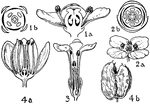
Orders of Aquifoliaceae, Celastraceae, Stackhousiaceae, and Staphyleaceae
The orders pictured are aquifoliaceae, celastraceae, stackhousiaceae, and staphyleaceae. The flowers…

Orders of Aceraceae, Hippocastanaceae, and Sapindaceae
The orders of aceraceae, hippocastanaceae, and sapindaceae. The flowers of these orders that are illustrated…
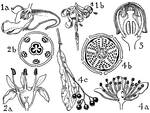
Orders of Balsaminaceae, Rhamnaceae, Vitaceae, and Tiliaceae
The orders pictured are balsaminaceae, rhamnaceae, vitaceae, and tiliaceae. The flowers of these orders…
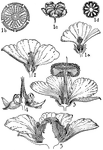
Orders of Malvaceae, Bombacaceae, and Dilleniaceae
The orders pictured are malvaceae, bombacaceae, and dilleniaceae. The flowers of these orders that are…
Order of Ochnaceae
Pictured are flowers from the order of ochnaceae. The flowers pictured are (1) ochna, (2) gordonia,…
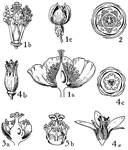
Orders of Hypericaceae, Guttiferae, and Tamaricaceae
The orders of hypericacea, guttiferae, and tamaricaceae are pictured. The flowers of these orders that…
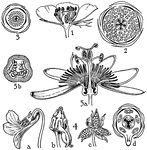
Orders of Cistaceae, Bixaceae, Violaceae, and Passifloraceae
Flowers of the orders of cistaceae, bixaceae, violaceae, and passifloraceae are pictured. These flowers…
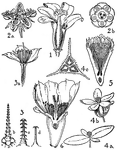
Orders of Caricaceae, Loasceae, Begoniaceae, and Cactaceae
Represented are the orders of caricaceae, loasaceae, begoniaceae, and cactaceae. The flowers of these…
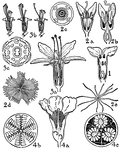
Orders of Thymelaeaceae, Elaeagnaceae, Lythraceae, and Punicaceae
Pictured are the orders of thymelaeaceae, elaeagnaceae, lythraceae, and punicaceae. The flowers of these…
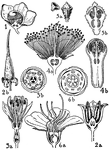
Orders of Lecythidaceae, Rhizophoraceae, Combretaceae, Myrtaceae, and Melastomaceae
Pictured are the orders of Lecythidaceae, Rhizophoraceae, Combretaceae, Myrtaceae, and Melastomaceae.…

Orders of Onagraceae and Haloragidaceae
Pictured are flowers from the orders onagraceae and haloragidaceae. The flowers of these orders that…
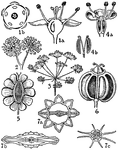
Orders of Araliaceae and Umbelliferae
Pictured are flowers of the orders araliaceae and umbelliferae. The flowers of these orders that are…
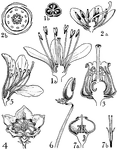
Orders of Clethraceae, Pyrolaceae, and Ericaceae
Pictured are the orders of clethraceae, pyrolaceae, and ericaceae. The flowers of these orders that…

Orders of Diapensiaceae, Primulaceae, and Plumbaginaceae
Pictured are flowers of the orders diapensiaceae, primulaceae, and plumbaginaceae. The flowers of these…
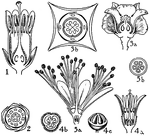
Orders of Sapotaceae, Ebenaceae, Styracaceae, and Symplocaceae
Pictured are flowers of the orders sapotaceae, ebenaceae, styracaceae, and symplocaceae. The flowers…
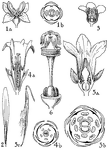
Orders of Oleaceae, Loganiaceae, Gentianaceae, and Apocynaceae
Pictured are the flowers and fruits of the orders oleaceae, loganiaceae, gentianaceae, and apocynaceae.…
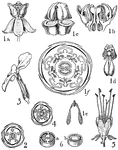
Orders of Asclepiadaceae, Convolvulaceae, Polemoniaceae, and Hydrophyllaceae
Pictured are flowers of the orders asclepiadaceae, convolvulaceae, polemoniaceae, and hydrophyllaceae.…
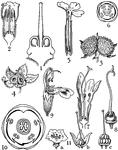
Orders of Boraginaceae, Verbenaceae, Labiatae, and Nolanaceae
Pictured are flowers of the order boraginaceae, verbenaceae, labiatae, and nolanaceae. The flowers of…
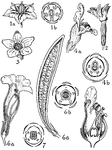
Orders of Solanaceae, Scrophylariaceae, Bignoniaceae, and Pedaliaceae.
Pictured are flowers of the orders solanaceae, scrophulariaceae, bignoiaceae, and pedaliaceae. The flowers…
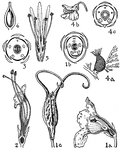
Orders of Martyniaceae, Gesneriaceae, Lentibulariaceae, and Globulariaceae
Pictured are flowers of the orders martyniaceae, gesneriaceae, lentibulariaceae, and globulariaceae.…

Orders of Acanthaceae, Myoporaceae, Phrymaceae, and Plantaginaceae
Pictured are flowers of the orders acanthaceae, myoporaceae, phrymaceae, and plantaginaceae. The flowers…

Orders of Rubiaceae and Valerianaceae
Pictured are flowers of the orders rubiaceae and valerianaceae. The flowers pictured are (1) galium,…
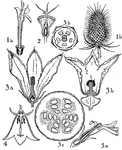
Orders of Dispsacaceae, Cucurbitaceae, and Campanulaceae
Pictured are flowers of the orders dipsacaceae, cucurbitaceae, and campanulaceae. The flowers illustrated…

Hemipterous Insect
Illustrated is a hemipterous insect, considered to be a true bug. It belongs to the order hemiptera.

Turbine Engine
The inner workings of the Carmania. A description of how the ship gets power in order to move on the…

Wind-Powered Sailboat
An image of a wind-powered sailboat. This sort of sailboat was developed in the 19th century for faster…
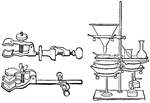
Lab Clamps
The first image is of clamps used in chemistry labs to hold test tubes and other apparatuses. The second…

Rock Crusher
A hand-generated rock crusher. Generally used to reduce rock to grainy substance in order to analyze…

Hancock Coaches
A Hancock Coach cross-sectioned in order to display the engine and driving connections. (A) is the exhaust…

Tea Drying in Baskets
Tea leaves are placed in tiered, horizontally arranged baskets. The floor has a channel running its…

Tea Leaf Treatment
A kuo basket is placed above a furnace to be hand-stirred by a worker in order to regulate the leaf…

Union of a Pyramid and a Prism of the Same Order
This illustration shows the union of a pyramid and a prism of the same order.
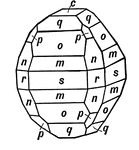
Hydrous Nickel Sulphate
This form shows the planes given on a crystal of hydrous nickel sulphate: the basal pinacoid, (c); three…
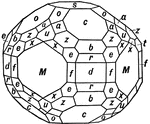
Vesuvianite
This form shows a very complex combination of thirteen tetragonal forms occuring on the mineral Vesuvianite:…

Lead Tungstate
Also known as Stolzite, this crystal is bounded by the unit pyramid of the first order, P, {111} (o),…
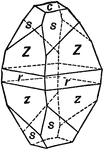
Yttrium Niobate
Also known as Fergusonite, this crystal shows the basal pinacoid, (c); the unit pyramid, (s); and the…

Scapolite
This figure shows a combination of forms sometimes observed on the silicate Scapolite, with the unit…

Calcium Phosphate, Apatite
This crystal of Calcium Phosphate, Apatite, represents a complex combination of hexagonal hemihedral…

Copper Silicate Showing Rhombohedral Tetartohedrism In the Hexagonal System
This is a crystal of Copper Silicate (Dioptase) with a rhombohedron of the third order, (s), in combination…
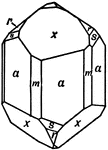
Phenacite
This crystal is mainly terminated by a rhombohedron of the third order, (x). With this form are associated…

Twin Rhombohedrons
This figure shows two twin rhombohedrons, symmetrical with reference to a prism of the first order,…
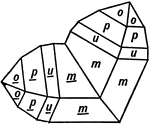
Zircon (Twinning)
In the tetragonal system, the unit pyramid of the second order is the most common twinning plane. This…
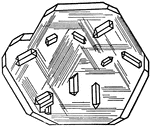
Rutile Growing Upon Titanic Iron
The tetragonal rutile grows upon the rhombohedral titanic iron, so that its prism of the second order,…
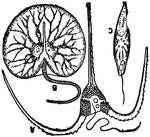
Flagellata
Flagellata is an order of Protozoa characterized by the presence of flagellae (whip-like structures…

Frankincense
Frankincense (Olibanum) is a gum resin obtained from Boswellia Carterii, of the order Burseraceae, and…

Common Fumitory
Fumitory, or Fumaria, is a genus of herbaceous plants belonging to the order Fumariaceae. The common…
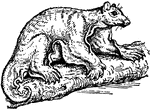
Galeopithecus
Galeopithecus is the generic name of certain mammals from the Malayan region, commonly (incorrectly)…
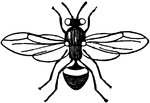
Gall-fly
Gall-fly is a name applied to the members of the family Cynipidae, which are not flies, but are related…
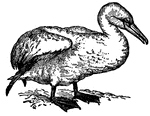
Gannet
Also known as a Solan Goose (Sula bassana), the Gannet is a large marine bird which nests in scattered…
Acipenser Sturio
A type of Ganoid fish. Ganoid is an order of fishes included seven living genera, whose members are…
Amia Occidentalis
A type of Ganoid fish. Ganoid is an order of fishes included seven living genera, whose members are…

Partial Section of Typical Large American Gas Holder
A gas holder is a metallic shell which is open at the bottom (like a bell), the lower edge of which…

Gentian
A genus of hardy plants, Gentians belong to the order Gentianaceae. They have a bitter taste, and one…

Glaux Maritima
Also known as Sea Milkwort, Glaux Maritima is a hardy perennial seashore plant belonging to the order…

Carding Process in the Manufacuring of Jute
After the softening process in the manufacturing of jute, the fibers are about six feet long, and are…

Jute
Jute, also known as Calcutta Hemp, is a fiber obtained from several species of the genus Corchorus of…

Clove Hitch
To tie a clove hitch, first pass the end 'a' around a spar, and cross it over 'b'. Pass it around the…
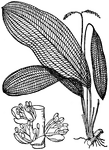
Lattice Leaf
Lattice Leaf is the popular name of a water plant, 'Aponogeton jenestralis', belonging to the order…

Cross of the Legion of Honor
The Cross of the Legion of Honor is a decoration composed of a star of five double rays, with a wreath…

Chrysalis
Typical forms of Chrysalis, the pupae of many Lepidoptera, an order of insects that includes moths and…